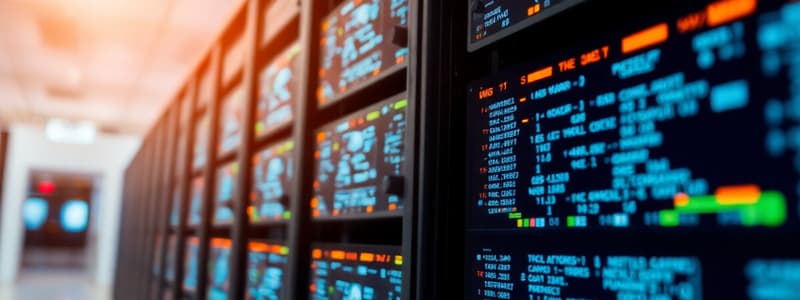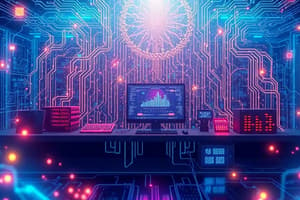Podcast
Questions and Answers
What is the primary function of a computer network?
What is the primary function of a computer network?
- To run a network operating system.
- To connect to international information banks.
- To hold shared files and programs.
- To share resources, exchange files, and enable electronic communications. (correct)
Which of the following accurately describes a key benefit of computer networks in a business environment?
Which of the following accurately describes a key benefit of computer networks in a business environment?
- Streamlined data entry via networked access to a common database. (correct)
- Elimination of the need for peripheral devices.
- Reduced information sharing among employees.
- Increased reliance on individual databases.
What is the role of a Network Interface Card (NIC) in a computer network?
What is the role of a Network Interface Card (NIC) in a computer network?
- To act as middleware between networks or computers.
- To provide access to network resources to all the users of the network.
- To provide hardware resources like printers to network users.
- To format and send data, receive data, and control data flow between the computer and the network. (correct)
Which component of a computer network is responsible for directing data between different networks?
Which component of a computer network is responsible for directing data between different networks?
Which type of network spans the largest geographical area?
Which type of network spans the largest geographical area?
What is a primary characteristic of a Local Area Network (LAN)?
What is a primary characteristic of a Local Area Network (LAN)?
Which describes a Metropolitan Area Network (MAN)?
Which describes a Metropolitan Area Network (MAN)?
Which of the following is the role of network protocols?
Which of the following is the role of network protocols?
What is the function of Transmission Control Protocol (TCP)?
What is the function of Transmission Control Protocol (TCP)?
What is the main purpose of the Internet Protocol (IP)?
What is the main purpose of the Internet Protocol (IP)?
Which protocol is specifically designed for file sharing between hosts?
Which protocol is specifically designed for file sharing between hosts?
What is the role of HTTP in the World Wide Web?
What is the role of HTTP in the World Wide Web?
What is the function of transmission media in a computer network?
What is the function of transmission media in a computer network?
Which of the following best describes the role of a 'client' in a computer network?
Which of the following best describes the role of a 'client' in a computer network?
How does a Network Operating System (NOS) facilitate communication in a computer network?
How does a Network Operating System (NOS) facilitate communication in a computer network?
Which of the following is an example of 'transmission media'?
Which of the following is an example of 'transmission media'?
What is the benefit of file sharing in computer networks?
What is the benefit of file sharing in computer networks?
In the context of computer networks, what components are categorized as 'peripherals'?
In the context of computer networks, what components are categorized as 'peripherals'?
Which statement correctly describes the relationship between the Internet, Intranet, and Extranet?
Which statement correctly describes the relationship between the Internet, Intranet, and Extranet?
Which of the following is essential for holding interactive conference and seminars for remote parties ?
Which of the following is essential for holding interactive conference and seminars for remote parties ?
Flashcards
What is a computer network?
What is a computer network?
Two or more computers linked to share resources, exchange files, or allow electronic communication.
File sharing?
File sharing?
Share data easily between users and access it remotely.
Resource sharing?
Resource sharing?
Using shared devices like printers. Copiers and sharing software to saves money .
Information sharing?
Information sharing?
Signup and view all the flashcards
What makes business more efficient with computer networks?
What makes business more efficient with computer networks?
Signup and view all the flashcards
What is a Server?
What is a Server?
Signup and view all the flashcards
What do Clients (Workstations) do?
What do Clients (Workstations) do?
Signup and view all the flashcards
What is Transmission media?
What is Transmission media?
Signup and view all the flashcards
Network Interface Card (NIC)
Network Interface Card (NIC)
Signup and view all the flashcards
What are Peripherals?
What are Peripherals?
Signup and view all the flashcards
What are communication switches?
What are communication switches?
Signup and view all the flashcards
Network Operating System
Network Operating System
Signup and view all the flashcards
What is a LAN (Local Area Network)?
What is a LAN (Local Area Network)?
Signup and view all the flashcards
MAN (Metropolitan Area Network)?
MAN (Metropolitan Area Network)?
Signup and view all the flashcards
What is a WAN (Wide Area Network)?
What is a WAN (Wide Area Network)?
Signup and view all the flashcards
What is a Network Protocol?
What is a Network Protocol?
Signup and view all the flashcards
Transmission Control Protocol (TCP)?
Transmission Control Protocol (TCP)?
Signup and view all the flashcards
Internet Protocol (IP)?
Internet Protocol (IP)?
Signup and view all the flashcards
What is File Transfer Protocol (FTP)?
What is File Transfer Protocol (FTP)?
Signup and view all the flashcards
Hyper Text Transfer Protocol (HTTP)?
Hyper Text Transfer Protocol (HTTP)?
Signup and view all the flashcards
Study Notes
- Computer networks enable sending messages with various media to multiple people, connecting to international information sources, holding remote conferences, and facilitating E-Learning, E-Commerce, and E-Government.
- These capabilities result from integrating communication and computer technologies to create computer networks.
Network Definition
- A network connects two or more computers to share resources like printers or CDs, exchange files, and facilitate electronic communication.
- Network connections can be wired or wireless, using cables, telephone lines, radio waves, satellites, or infrared light beams.
Benefits of Computer Networks
- File sharing is simplified, allowing data access across different users or remote access.
- Resource sharing reduces costs by enabling shared network peripherals like printers and software.
- Information sharing and communication become easier.
- Business efficiency is improved, illustrated by avoiding multiple data entries through networked access to a common database preventing errors and saving time.
Computer Network Components
- A computer network comprises several components, each with its own function.
- Key components are: a server, clients, transmission media, network interface card, peripherals, communication switches, and a network operating system.
Computer Network Component Details
- Servers store shared files, programs, and the network operating system providing access to network resources.
- Servers are fast with high processing speeds and large storage capacity.
- Clients, or workstations, request and receive services from servers to access and use network resources.
- Transmission media carry data between devices in a network.
- Transmission media can be guided, like coaxial or fiber optic cables, or unguided, like microwaves and infra-red waves.
- A network interface card (NIC) on each computer prepares/formats, sends, and receives data, controlling its flow.
- Peripherals are hardware resources like printers and scanners provided by servers.
- Communication switches, such as routers, hubs, switches, and repeaters, connect devices as middleware to bind network media.
- Network operating systems are programs on computers/servers enabling communication over the network.
Computer Network Types
- Computer networks are categorized by size, falling into three main types.
- The three types are: LANs, MANs, and WANs.
LAN (Local Area Network)
- LANs connect computers in a small area like a building or office.
- LAN data transfers occur at extremely fast rates.
- LANs provide a high level of security.
MAN (Metropolitan Area Network)
- MANs cover larger geographic areas by interconnecting LANs.
- MANs connect various LANs.
- MANs have a higher range than LANs.
WAN (Wide Area Network)
- WANs extend over large geographical areas like states or countries.
- WANs are larger than LANs.
- WANs span large geographical areas via telephone lines, fiber optic cables, or satellite links.
- The internet is one of the largest WANs worldwide.
- WANs are widely used in business, government, and education.
Network Protocols
- A network protocol establishes rules that govern data transmission, device communication, data sending, and error management in a network.
Types of Protocols
- Transmission Control Protocol (TCP) is a common communication protocol that divides messages into packets for transmission and reassembly.
- Internet Protocol (IP) is designed for addressing and is often used with TCP; IP addresses in packets route them to the destination system through different nodes.
- File Transfer Protocol (FTP) enables file sharing between hosts using a connection made for the file transfer.
- Hyper Text Transfer Protocol (HTTP) is used for hypertext transfer in the World Wide Web via a request/response model.
- With HTTP the client sends a request to the server, which is processed before a response is sent back.
Studying That Suits You
Use AI to generate personalized quizzes and flashcards to suit your learning preferences.




